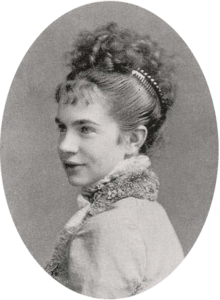Archduchess Gisela of Austria
Archduchess Gisela of Austria, Royal Princess of Hungary, Croatia and Bohemia or Princess Leopold of Bavaria (born Gisela Louise Marie on 12 July 1856 – 27 July 1932) was the second daughter and eldest surviving child of Emperor Franz Joseph I of Austria and Empress Elisabeth. Her German title was Gisela Louise Marie, Erzherzogin von Österreich, Prinzessin von Bayern.
Life
Although christened Gisella (with a double L) she only ever wrote her name with one L. She was named after a 10th-century Habsburg ancestress. Just like her older sister and her brother, Gisela was raised by her paternal grandmother, Archduchess Sophie of Austria. She had a very close relationship with her younger brother, Crown Prince Rudolf, whose suicide hit her hard.
Her father collected some the family's personal items, such as the first pair of shoes worn by each of his children. Among these keepsakes was a poem written for him by a young Gisela one Christmas - the poem was said to be the most treasured item among this collection. Archduchess Gisela was also known to paint in her later years.
Marriage and Family
On 20 April 1873, Gisela was married to Prince Leopold of Bavaria in Vienna. Prince Leopold was a son of Prince Regent Luitpold of Bavaria and Auguste Ferdinande of Austria and Gisela's second cousin.
According to a letter to his mother written in 1872, Emperor Franz Josef wanted the match between his daughter and Prince Leopold, as there were so few Catholic princes available at that time. It seems he felt he had to secure the only viable candidate to whom he could give Gisela (whom he called "our darling girl" during the wedding rites) with confidence.
Gisela was made welcome in Munich by her husband's family, and they lived in the Palais Leopold in Schwabing. The street opposite the Palais was renamed Giselastraße in her honor in 1873. A year after her wedding, Gisela gave birth to her first child Elisabeth Marie. She had four children in total.
Issue
Gisela and Prince Leopold of Bavaria had four children:
- Princess Elisabeth Marie of Bavaria (1874–1957), who married Otto Ludwig Philipp Graf von Seefried auf Buttenheim
- Princess Auguste Maria of Bavaria (1875–1964), who married Joseph August, Archduke of Austria
- Prince Georg of Bavaria (1880–1943), who married Archduchess Isabella of Austria
- Prince Konrad of Bavaria (1883–1969), who married Princess Bona Margherita of Savoy-Genoa
Charity works and World War I
She was deeply involved in a variety of social and political issues and founded charities to support the poor, blind and deaf people where she took an active role herself.
During World War I she ran a military hospital in her Palais while her husband was a field marshal on the eastern front. When the Revolution broke out in 1918, the rest of her family fled the city, but Gisela remained and took part in the 1919 elections for the Weimar National Assembly where women above the age of 20 were allowed to vote for the first time.
Such was the esteem in which she was held that she was commonly known as the Good Angel from Vienna and became patron for a number of institutions, such as the Giselabahn (a train running from Salzburg to Tirol), the still active paddle steamer Gisela on the Traunsee and the Gisela Gymnasium in Munich.
Widowhood & Death
Gisela and her husband celebrated their golden wedding anniversary in 1923. Her husband died in 1930, and Gisela only survived him by two years. She died aged 76 in Munich on 27 July 1932, and is buried next to Prince Leopold in the Colombarium at the St.Michaelskirche, Munich.
Honours
She received the following orders:[1]
-
.svg.png) Austria-Hungary : Dame of the Order of the Starry Cross
Austria-Hungary : Dame of the Order of the Starry Cross -
.svg.png) Austria-Hungary : Grand Cross of the Order of Elizabeth
Austria-Hungary : Grand Cross of the Order of Elizabeth -
.svg.png) Kingdom of Bavaria : Dame of the Order of Theresa
Kingdom of Bavaria : Dame of the Order of Theresa -
.svg.png) Kingdom of Bavaria : Dame of the Order of Saint Elizabeth
Kingdom of Bavaria : Dame of the Order of Saint Elizabeth -
.svg.png) Kingdom of Portugal : Dame of the Order of Saint Isabel
Kingdom of Portugal : Dame of the Order of Saint Isabel -
 Spain : 601st Dame of the Order of Queen Maria Luisa -
Spain : 601st Dame of the Order of Queen Maria Luisa - _-_ribbon_bar.png) .
.
Ancestry
Notes
References
- Leopold Prinz von Bayern: Lebenserinnerungen
- Martha Schad: Kaiserin Elisabeth und ihre Töchter, Piper 2006
- Friedrich Weissensteiner: Liebeshimmel und Ehehöllen, Heyne 2000

.svg.png)